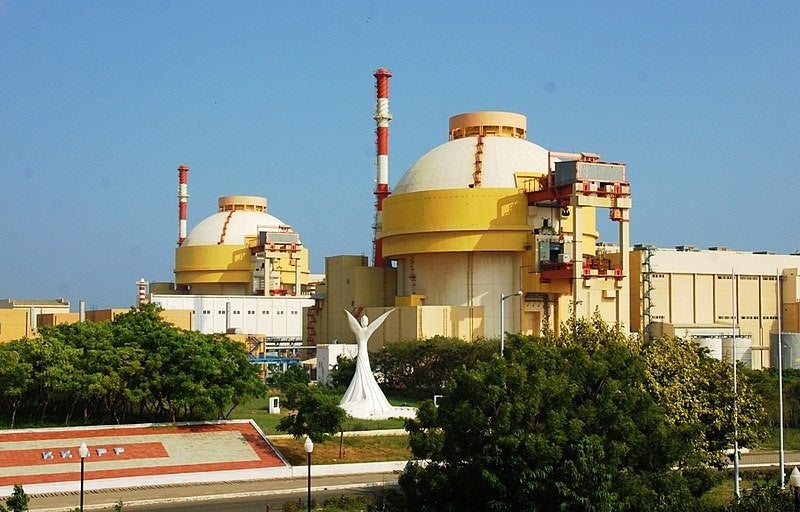
Nuclear power plants in India
Nuclear power in India delivers a total capacity of 6.7GW, contributing to just under 2% of the country’s electricity supply. India’s nuclear plants are controlled by Nuclear Power Corporation of India (NPCIL), a state-owned corporation which was founded in 1987. India boasts a fleet of seven nuclear power plants, profiled here in order of size from largest production capacity to smallest.
Kudankulam Nuclear Power Plant, Tamil Nadu
Kudankulam Nuclear Power Plant is located in the Tamil Nadu, Southern India. It is the highest-capacity nuclear plant in India, with a total of 2,000MW currently installed with a further 2,000MW under construction.

Discover B2B Marketing That Performs
Combine business intelligence and editorial excellence to reach engaged professionals across 36 leading media platforms.
Kudankulam is the only nuclear plant in India that uses pressurised water reactors (PWR) rather than boiling water reactors (BHWR) or pressurised heavy-water reactors (PHWR). The PWRs are based on Russian technology and were supplied by Atomstroyexport.
Construction was halted on the project in October 2011 after protests against the plant led by The People’s Movement against Nuclear Energy in the wake of Fukushima. The Indian Supreme Court dismissed the protestor’s public suit against the plant in May 2013.
Tarapur Nuclear Reactor, Maharashtra
The Tarapur Nuclear Reactor in Maharashtra, Western India is the oldest nuclear facility in India, having commenced commercial operations in 1969.
The reactor is currently the second most powerful in India, with two BHWR of 160MW and two PHWR reactors of 540MW forming a total of 1,400MW.

US Tariffs are shifting - will you react or anticipate?
Don’t let policy changes catch you off guard. Stay proactive with real-time data and expert analysis.
By GlobalDataThe two BHWR were part of the initial installation in 1969, with the two PHWR reactors being added in 2005 and 2006.
Rajasthan Atomic Power Plant, Rajasthan
The Rajasthan Power Plant in Rajasthan, North-Western India has a total installed capacity of 1180MW. Formed of six PHWR reactors with two more reactors planned, the first reactor was commissioned back in December 1973.
The plant was the target of protestors from the local chapter of the now ruling Indian People’s Party (BJP) in June 2012. The BJP called for a bandh – a protest similar to a strike – and led a protest rally against the plant, resulting in mass arrests of the protestors.
Kaiga Atomic Power Plant, Karnataka
The Kaiga Atomic Power Plant in Karanataka, Western India is formed of four 220MW PHWR reactors making a total of 880MW. The reactors became operational in December 1999, October 2000, April 2007 and January 2011.
Unit 1 of the Kaiga plant set the world record for continuous operation in December 2018. It had 962 days of unbroken operation from the 13 May 2016 to 31 December 2018, surpassing the previous record set by Heysham 2 in the UK by 22 days.
Kalapakkam Nuclear Power Plant, Tamil Nadu
Kalapakkam Nuclear Power Plant in Tamil Nadu first began operating in 1984 and currently has two 235MW reactors, with two more reactors of 500MW and 600MW to be added at a later date.
Kalapakkam has a prototype fast breeder reactor (PFBR) which does not produce highly radioactive nuclear waste and can produce 70% more energy.
The reactor survived the Vardah cyclone when winds of up to 90mph hit Tamil Nadu province in December 2016.
Narora Nuclear Reactor, Uttar Pradesh
The Narora Nuclear Reactor in Uttar Pradesh, Northern India has two PHWR which offer a total capacity of 440MW. Unit 1 was installed in January 1991, and unit 2 following in July 1992.
Despite a major fire occurring in unit 1 in May 1993 and unit 2 being out of service for a month after an air-locking inner door malfunction in September 1999, Narora is considered one for the safest nuclear plants in the country and won a Golden Peacock award for environment management in the year 2000.
Kakarapar Atomic Power Plant, Gujarat
The Kakarapar Atomic Power Plant in Gujarat, Western India has two PHWR reactors with a total installed capacity of 440MW. The two reactors were completed in May 1993 and September 1995 respectively.
The plant was shut down for 66 days in 1998 due to a leak in its water systems, but it recovered to be awarded the best PHWR in its class by the CANDU owners group in January 2003.
The plant also received a successful ‘heart transplant’ in September 2018 when all of its coolant channel and feeder tubes at the core of its reactor were replaced.



